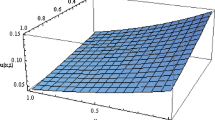Abstract
We introduce an innovative postprocessing technique aimed at refining the accuracy of the discontinuous Galerkin method for solving linear delay differential equations (DDEs) with vanishing delays. The fundamental idea behind this postprocessing technique is to enhance the discontinuous Galerkin solution of degree k by incorporating a generalized Jacobi polynomial of degree \(k+1\). We demonstrate that this postprocessing step enhances convergence by one order under the \(L^\infty \)-norm. Moreover, we apply this technique to both nonlinear DDEs with vanishing delays and linear DDEs with non-vanishing delays. We further validated the theoretical results through a series of numerical examples.
Similar content being viewed by others
References
Amirali, I.: Stability properties for the delay integro-differential equation. GAU J. Sci. 36, 862–868 (2023)
Amirali, I., Acar, H.: A novel approach for the stability inequalities for high-order Volterra delay integro-differential equation. J. Appl. Math. Comput. 69, 1057–1069 (2023)
Amirali, I., Acar, H.: Stability inequalities and numerical solution for neutral Volterra delay integro-differential equation. J. Comput. Appl. Math. 436, 115343 (2024)
Amiraliyeva, I.G., Erdogan, F., Amiraliyev, G.M.: A uniform numerical method for dealing with a singularly perturbed delay initial value problem. Appl. Math. Lett. 23, 1221–1225 (2010)
Arino, O., Hbid, M.L., Ait Dads, E.: Delay Differential Equations and Applications. NATO Sciences Series, Springer, Berlin (2006)
Bellen, A.: One-step collocation for delay differential equations. J. Comput. Appl. Math. 10, 275–283 (1984)
Bellen, A., Zennaro, M.: Numerical solution of delay differential equations by uniform corrections to an implicit Runge-Kutta method. Numer. Math. 47, 301–316 (1985)
Bellen, A., Zennaro, M.: Numerical Methods for Delay Differential Equations. Oxford University Press, Oxford (2003)
Brunner, H., Huang, Q., Xie, H.: Discontinuous Galerkin methods for delay differential equations of pantograph type. SIAM J. Numer. Anal. 48, 1944–1967 (2010)
Brunner, H., Liang, H.: Stability of collocation methods for delay differential equations with vanishing delays. BIT 50, 693–711 (2010)
Ciarlet, P.G.: The Finite Element Method for Elliptic Problems. North-Holland, Amsterdam (1978)
Deng, K., Xiong, Z.G., Huang, Y.Q.: The Galerkin continuous finite element method for delay differential equation with a variable term. Appl. Math. Comput. 186, 1488–1496 (2007)
Huang, C.M., Fu, H.Y., Li, S.F., Chen, G.N.: Stability analysis of Runge-Kutta methods for non-linear delay differential equations. BIT 39, 270–280 (1999)
Huang, Q.M., Jiang, K., Xu, X.X.: Postprocessing of continuous Galerkin solutions for delay differential equations with nonlinear vanishing delay. Int. J. Numer. Anal. Model. 16, 718–730 (2019)
Huang, Q.M., Xie, H.H., Brunner, H.: Superconvergence of discontinuous Galerkin solutions for delay differential equations of pantograph type. SIAM J. Sci. Comput. 33, 2664–2684 (2011)
Huang, Q.M., Xie, H.H., Brunner, H.: The \(hp\) discontinuous Galerkin method for delay differential equations with nonlinear vanishing delay. SIAM J. Sci. Comput. 35, A1604–A1620 (2013)
Huang, Q.M., Xu, X.X., Brunner, H.: Continuous Galerkin methods on quasi-geometric meshes for delay differential equations of pantograph type. Discrete Contin. Dyn. Syst. 36, 5423–5443 (2016)
Kuang, Y.: Delay Differential Equations with Applications in Population Dynamics. Academic Press, Boston (1993)
Kudu, M., Amirali, I., Amiraliyev, G.M.: A finite-difference method for a singularly perturbed delay integro-differential equation. J. Comput. Appl. Math. 308, 379–390 (2016)
Li, D.F., Zhang, C.J.: Superconvergence of a discontinuous Galerkin Method for first-order linear delay differential equations. J. Comput. Math. 29, 574–588 (2011)
Li, D.F., Zhang, C.J.: \(L^\infty \) error estimates of discontinuous Galerkin methods for delay differential equations. Appl. Numer. Math. 82, 1–10 (2014)
Maset, S.: Stability of Runge-Kutta methods for linear delay differential equations. Numer. Math. 87, 355–371 (2000)
Meng, T.T., Yi, L.J.: An \(h\)-\(p\) version of the continuous Petrov-Galerkin method for nonlinear delay differential equations. J. Sci. Comput. 74, 1091–1114 (2018)
Meng, T.T., Yi, L.J.: An \(h\)-\(p\) version of the Chebyshev spectral collocation method for nonlinear delay differential equations, Numer. Methods Partial. Differ. Equ. 35, 664–680 (2018)
Mitsui, T., Hu, G.D.: Numerical Analysis of Ordinary and Delay Differential Equations. Springer, Singapore (2023)
Schötzau, D., Schwab, C.: An \(hp\) a priori error analysis of the DG time-stepping method for initial value problems. Calcolo. 37, 207–232 (2000)
Shen, J., Tang, T., Wang, L.L.: Spectral Methods: Algorithms, Analysis and Applications, Springer Series in Computational Mathematics, vol. 41. Springer, Heidelberg (2011)
Smith, H.: An Introduction to Delay Differential Equations with Applications to the Life Sciences. Springer, New York (2011)
Takama, N., Muroya, Y., Ishiwata, E.: On the attainable order of collocation methods for delay differential equations with proportional delay. BIT 40, 374–394 (2000)
Thomée, V.: Galerkin Finite Element Methods for Parabolic Problems, Springer Series in Computational Mathematics, vol. 25. Springer-Verlag, Berlin (2006)
Wei, Y.C., Sun, T., Yi, L.J.: An \(hp\)-version of the discontinuous Galerkin time-stepping method for nonlinear second-order delay differential equations with vanishing delays. J. Comput. Appl. Math. 364, 112348 (2020)
Xie, J.H., Yi, L.J.: An \(h\)-\(p\) version of the continuous Petrov-Galerkin time stepping method for nonlinear second-order delay differential equations. Appl. Numer. Math. 143, 1–19 (2019)
Xu, X.X., Huang, Q.M.: Superconvergence of discontinuous Galerkin methods for nonlinear delay differential equations with vanishing delay. J. Comput. Appl. Math. 348, 314–327 (2019)
Xu, X.X., Huang, Q.M., Chen, H.T.: Local superconvergence of continuous Galerkin solutions for delay differential equations of pantograph type. J. Comput. Math. 34, 186–199 (2016)
Yi, L.J., Zhang, M.Z., Mao, X.Y.: Superconvergent postprocessing of the discontinuous Galerkin time stepping method for nonlinear Volterra integro-differential equations. J. Comput. Appl. Math. 427, 115140 (2023)
Zhang, M.Z., Mao, X.Y., Yi, L.J.: Superconvergence and postprocessing of the continuous Galerkin method for nonlinear Volterra integro-differential equations. ESAIM Math. Model. Numer. Anal. 57, 671–691 (2023)
Zhang, M.Z., Yi, L.J.: Superconvergent postprocessing of the continuous Galerkin time stepping method for nonlinear initial value problems with application to parabolic problems. J. Sci. Comput. 94, 31 (2023)
Zhang, M.Z., Yi, L.J.: Postprocessing techniques of high-order Galerkin approximations to nonlinear second-order initial value problems with applications to wave equations, Commun. Comput. Phys. 35, 816–858 (2024)
Author information
Authors and Affiliations
Corresponding author
Ethics declarations
Conflict of interest
The authors declare that they have no Conflict of interest.
Additional information
Publisher's Note
Springer Nature remains neutral with regard to jurisdictional claims in published maps and institutional affiliations.
L. Yi: The work is supported by the National NSF of China (Grant Nos. 12171322, 11771298 and 12271366) and the NSF of Shanghai (Grant Nos. 21ZR1447200 and 22ZR1445500).
Some proofs
Some proofs
1.1 Proof of Lemma 2.1
Proof
Since the \(L^\infty \)-error estimate (2.4) has been established in [16, Corollary 3.4], our task is now reduced to verifying the \(L^2\)- and \(H^1\)-error estimates.
Step 1. We will show the \(L^2\)-error estimate in (2.3). Utilizing (1.1) and (2.2), it follows that
Since \(e = \xi + \eta \), using (A.1), (2.12), integration by parts, and the fact \(\xi ^-_0=0\), we derive
Further application of integration by parts yields
By selecting \(\varphi = \xi \) in (A.2), we obtain
which implies
Summing (A.4) over \( I_i\) for \(1\le i \le n\), then utilizing
we obtain
For \(k=0\), we have \(\xi '=0\). Utilizing (A.6), we obtain
For \(k>0\), selecting \(\varphi = t_{n-1}-t \) in (A.3), we obtain
Then, using (A.6) gives
Here, we have utilized the fact
Combining (A.7) and (A.9), we conclude
For \(k>0\), selecting \(\varphi =\xi ^{\prime }(t)(t-t_{n-1})\) in (A.2) and then utilizing (A.10) and the Cauchy-Schwarz inequality, we have
and thus,
For \(k=0\), where \(\xi '=0\), (A.12) still holds.
Recalling the inequality (see [26, Lemma 2.4])
Then, using (A.11) and (A.12), we obtain
which implies that for \(h_n\) sufficiently small
Therefore, applying the discrete Gronwall inequality yields
Combining (2.18) and (A.14), we obtain
This concludes the proof of the \(L^2\)-estimate in (2.3).
Step 2. In this step, we establish the \(H^1\)-error estimate in (2.3). Given that \(\xi |_{I_n} \in P_{k}(I_{n})\), we utilize the inverse inequality (see, e.g., [11])
and the fact \(\Vert L_{n,k}\Vert _{L^{2}(I_{n})}=\left( \displaystyle \frac{h_n}{2k+1}\right) ^\frac{1}{2} \le C h_n^{\frac{1}{2}}\) to obtain
Choosing \(\varphi =\xi ^{\prime }-(-1)^{k}\xi ^{\prime }(t_{n-1}^{+})L_{n,k}\) in (A.2) and utilizing (A.17) as well as the properties \(\varphi _{n-1}^+=0\), we arrive at
which leads to
Squaring and summing (A.18) over \(I_n\) for \(1\le n \le N\), then utilizing (A.5), we have
Combining (A.19), (2.18), and (2.3), we obtain
which along with (A.15) implies the desired \(H^1\)-estimate. \(\square \)
1.2 Proof of Lemma 2.2
Proof
We begin by constructing the following problem: seek v so that
for \(1\le n\le N\), and \(\widetilde{b}\) is given as follows:
Here, the functions a, b, and \(\theta \) are given by (1.1).
Because of the potential discontinuity of \(\widetilde{b}\) at the points \(\theta (t_n)\), the derivative \(v'\) may also exhibit discontinuity at these points. We make the assumption that the functions a and b belong to \(C^k(I)\) such that v satisfies the inequality
for \(i=0,1,...,k+1\), where \(t \in [0,\theta (t_n))\cup (\theta (t_n),t_n]\).
For convenience, let’s define
Utilizing the technique of integration by parts, yields
By summing up (A.23) over \(I_i\), \(1 \le i \le n\), and utilizing (A.20), the initial condition \(e_0^-=u_0-U_0^-=0\), and the fact \(v\in H^1(0, t_n)\), we get
Since \(e = \xi + \eta \) and using (2.18), (A.18), (A.10), and (2.3), we have
Now, considering (A.22), (A.1), and employing (2.13), we find that
where \(\hat{\pi }_{I_n}^kv \in P_k(I_n)\) denote the projection of v as defined by (2.13).
Let \(n^*\) be an integer such that \(\theta (t_n)\) falls within \([t_{n^*-1},t_{n^*+1}]\), where \(1\le n^*\le n-1\). By (A.26) and(A.24), we have
with
Applying the Cauchy-Schwarz inequality, (A.25), (2.3), and (2.20), we get
It’s worth noting that v may possess lower regularity on the intervals \(I_{j}\), \(j=n^{*},n^{*}+1\). Similar to the derivation of \(A_1\), we obtain
Moreover, we can estimate \(A_3\) in a similar manner to \(A_1\), obtaining
Finally, by combining (A.27)-(A.30), we derive the desired estimate
which implies (2.5). \(\square \)
Rights and permissions
Springer Nature or its licensor (e.g. a society or other partner) holds exclusive rights to this article under a publishing agreement with the author(s) or other rightsholder(s); author self-archiving of the accepted manuscript version of this article is solely governed by the terms of such publishing agreement and applicable law.
About this article
Cite this article
Tu, Q., Li, Z. & Yi, L. Postprocessing technique of the discontinuous Galerkin method for solving delay differential equations. J. Appl. Math. Comput. (2024). https://doi.org/10.1007/s12190-024-02114-3
Received:
Revised:
Accepted:
Published:
DOI: https://doi.org/10.1007/s12190-024-02114-3




